I have XML data (GraphML) i need to transform for my application. The XML represents a graph, that has nodes of labels "User" and "Item", and edges of label "HAS_HOBBY" and "FRIEND_OF".
Given a specific user, I want to get after the transform all his friends that share at least one hobby with him, and those hobbies (represented by items). "friends" are represented by "FRIEND_OF" edge element, and hobbies by "HAS_HOBBY".
I have my XSLT (i'm kinda new at this) that can find the items needed and the friends, however in my logic i cant manage to copy a friend just once - it is done once for every hobby he shares with the original user. I do this by going over each of the friend's hobbies for each of the user's hobbies, and when there's a match - i print the item (hobby) (which is okay), and the friend - however this friend is printed every time a match is found, resulting in multiple occurrences of this friend, which is undesired.
I tried searching for ways to avoid this, but i think my entire logic is flawed implementing this solution. I have no other ideas, though.
Here's my XSL:
<?xml version="1.0"?>
<xsl:stylesheet version="1.0"
xmlns:xsl="http://www.w3.org/1999/XSL/Transform"
xmlns:ns="http://graphml.graphdrawing.org/xmlns"
xmlns="http://graphml.graphdrawing.org/xmlns"
exclude-result-prefixes="ns #default">
<xsl:strip-space elements="*"/>
<xsl:output indent="yes"/>
<!--Identity template: default copy all content into the output -->
<xsl:template match="node()|@*">
<xsl:copy>
<xsl:apply-templates select="node()|@*"/>
</xsl:copy>
</xsl:template>
<!-- Don't copy tags called 'node or edge' -->
<xsl:template match="ns:node" />
<xsl:template match="ns:edge" />
<xsl:template match="ns:node[ns:data[@key='username' and . = 'c']]">
<xsl:copy>
<xsl:apply-templates select="node()|@*"/>
</xsl:copy>
<xsl:variable name="USERID" select="@id"/>
<xsl:for-each select="//ns:edge">
<xsl:if test="@source=$USERID">
<xsl:variable name="TARGET" select="@target"/>
<xsl:for-each select="//ns:node[@id=$TARGET]">
<!-- finds USERNAME's hobbies -->
<xsl:for-each select="//ns:edge[@source=$USERID and @label='HAS_HOBBY']">
<xsl:variable name="HOBBYTARGET" select="@target"/>
<xsl:for-each select="//ns:edge[@source=$TARGET and @label='HAS_HOBBY']">
<xsl:if test="@target=$HOBBYTARGET">
<!-- Shared hobby with friend -->
<xsl:for-each select="//ns:node[@id=$HOBBYTARGET]">
<xsl:copy>
<xsl:apply-templates select="node()|@*"/>
</xsl:copy>
</xsl:for-each>
</xsl:if>
</xsl:for-each>
</xsl:for-each>
</xsl:for-each>
</xsl:if>
<xsl:if test="@target=$USERID">
<xsl:variable name="SOURCE" select="@source"/>
<xsl:for-each select="//ns:node[@id=$SOURCE]">
<!-- finds USERNAME's hobbies -->
<xsl:for-each select="//ns:edge[@source=$USERID and @label='HAS_HOBBY']">
<xsl:variable name="HOBBYTARGET" select="@target"/>
<xsl:for-each select="//ns:edge[@source=$SOURCE and @label='HAS_HOBBY']">
<xsl:if test="@target=$HOBBYTARGET">
<!-- Shared hobby with friend -->
<xsl:for-each select="//ns:node[@id=$HOBBYTARGET]">
<xsl:copy>
<xsl:apply-templates select="node()|@*"/>
</xsl:copy>
</xsl:for-each>
</xsl:if>
</xsl:for-each>
</xsl:for-each>
</xsl:for-each>
</xsl:if>
</xsl:for-each>
</xsl:template>
</xsl:stylesheet>
At the moment the friend's copy is missing but it would be right after the "Shared hobby with friend" comment.
I realised i cant use a 'flag' type variable (since its not possible..) and there's no way to have arrays or some similar data structure, so im really out of ideas.
Please, help me to get a user's friends that he shares atleast one hobby (item) with, and the hobbies themselves.
EDIT: Sample Input: I added graph visualisation as well so its easy to see
<?xml version="1.0" encoding="UTF-8"?>
<graphml xmlns="http://graphml.graphdrawing.org/xmlns" xmlns:xsi="http://www.w3.org/2001/XMLSchema-instance" xsi:schemaLocation="http://graphml.graphdrawing.org/xmlns http://graphml.graphdrawing.org/xmlns/1.0/graphml.xsd">
<graph id="G" edgedefault="directed">
<node id="n2" labels=":Item"><data key="labels">:Item</data><data key="itemId">Q1</data></node>
<node id="n32" labels=":Item"><data key="labels">:Item</data><data key="itemId">Q8</data></node>
<node id="n51" labels=":Item"><data key="labels">:Item</data><data key="itemId">Q23</data></node>
<node id="n897" labels=":Item"><data key="labels">:Item</data><data key="itemId">Q55</data></node>
<node id="n406727" labels=":User"><data key="labels">:User</data><data key="hobbies">[Ljava.lang.String;@78ba00a3</data><data key="firstName">a</data><data key="imgPath">/uploads/a.png</data><data key="surName">a</data><data key="username">a</data><data key="gender">Male</data><data key="relaStatus">Single</data></node>
<node id="n406729" labels=":User"><data key="labels">:User</data><data key="hobbies"></data><data key="firstName">b</data><data key="imgPath">/uploads/b.png</data><data key="surName">b</data><data key="username">b</data><data key="gender">Male</data><data key="relaStatus">Single</data></node>
<node id="n406731" labels=":User"><data key="labels">:User</data><data key="hobbies"></data><data key="blocked">[Ljava.lang.String;@7b800b40</data><data key="firstName">c</data><data key="imgPath">/uploads/c.png</data><data key="surName">c</data><data key="username">c</data><data key="gender">Male</data><data key="relaStatus">Single</data></node>
<node id="n406734" labels=":User"><data key="labels">:User</data><data key="hobbies"></data><data key="firstName">d</data><data key="imgPath">/uploads/d.png</data><data key="surName">d</data><data key="username">d</data><data key="gender">Male</data><data key="relaStatus">Single</data></node>
<edge id="e1223400" source="n406727" target="n406729" label="FRIEND_OF"><data key="label">FRIEND_OF</data></edge>
<edge id="e1223403" source="n406727" target="n406731" label="FRIEND_OF"><data key="label">FRIEND_OF</data></edge>
<edge id="e1223405" source="n406734" target="n406731" label="FRIEND_OF"><data key="label">FRIEND_OF</data></edge>
<edge id="e1223405" source="n406727" target="n406734" label="FRIEND_OF"><data key="label">FRIEND_OF</data></edge>
<edge id="e1223374" source="n406727" target="n2" label="HAS_HOBBY"><data key="label">HAS_HOBBY</data></edge>
<edge id="e1223385" source="n406727" target="n51" label="HAS_HOBBY"><data key="label">HAS_HOBBY</data></edge>
<edge id="e1223383" source="n406729" target="n2" label="HAS_HOBBY"><data key="label">HAS_HOBBY</data></edge>
<edge id="e1223384" source="n406731" target="n2" label="HAS_HOBBY"><data key="label">HAS_HOBBY</data></edge>
<edge id="e1223375" source="n406731" target="n51" label="HAS_HOBBY"><data key="label">HAS_HOBBY</data></edge>
<edge id="e1223371" source="n406734" target="n897" label="HAS_HOBBY"><data key="label">HAS_HOBBY</data></edge>
</graph>
</graphml>
And here's the sample output. You can see that only c and b are left in the result since they have common hobbies (items with Q) with a. so d, the edge a-d and Q51, Q8 are gone.
<?xml version="1.0" encoding="UTF-8"?>
<graphml xmlns="http://graphml.graphdrawing.org/xmlns" xmlns:xsi="http://www.w3.org/2001/XMLSchema-instance" xsi:schemaLocation="http://graphml.graphdrawing.org/xmlns http://graphml.graphdrawing.org/xmlns/1.0/graphml.xsd">
<graph id="G" edgedefault="directed">
<node id="n2" labels=":Item"><data key="labels">:Item</data><data key="itemId">Q1</data></node>
<node id="n51" labels=":Item"><data key="labels">:Item</data><data key="itemId">Q23</data></node>
<node id="n406727" labels=":User"><data key="labels">:User</data><data key="hobbies">[Ljava.lang.String;@78ba00a3</data><data key="firstName">a</data><data key="imgPath">/uploads/a.png</data><data key="surName">a</data><data key="username">a</data><data key="gender">Male</data><data key="relaStatus">Single</data></node>
<node id="n406729" labels=":User"><data key="labels">:User</data><data key="hobbies"></data><data key="firstName">b</data><data key="imgPath">/uploads/b.png</data><data key="surName">b</data><data key="username">b</data><data key="gender">Male</data><data key="relaStatus">Single</data></node>
<node id="n406731" labels=":User"><data key="labels">:User</data><data key="hobbies"></data><data key="blocked">[Ljava.lang.String;@7b800b40</data><data key="firstName">c</data><data key="imgPath">/uploads/c.png</data><data key="surName">c</data><data key="username">c</data><data key="gender">Male</data><data key="relaStatus">Single</data></node>
<edge id="e1223400" source="n406727" target="n406729" label="FRIEND_OF"><data key="label">FRIEND_OF</data></edge>
<edge id="e1223403" source="n406727" target="n406731" label="FRIEND_OF"><data key="label">FRIEND_OF</data></edge>
<edge id="e1223405" source="n406734" target="n406731" label="FRIEND_OF"><data key="label">FRIEND_OF</data></edge>
<edge id="e1223374" source="n406727" target="n2" label="HAS_HOBBY"><data key="label">HAS_HOBBY</data></edge>
<edge id="e1223385" source="n406727" target="n51" label="HAS_HOBBY"><data key="label">HAS_HOBBY</data></edge>
<edge id="e1223383" source="n406729" target="n2" label="HAS_HOBBY"><data key="label">HAS_HOBBY</data></edge>
<edge id="e1223384" source="n406731" target="n2" label="HAS_HOBBY"><data key="label">HAS_HOBBY</data></edge>
<edge id="e1223375" source="n406731" target="n51" label="HAS_HOBBY"><data key="label">HAS_HOBBY</data></edge>
</graph>
</graphml>
Thank you for your time.
Edit#2: Added data for label nodes and hasLabel edges:
<node id="n3" labels=":Label"><data key="labels">:Label</data><data key="en-gb">Universe</data>
<edge id="e0" source="n2" target="n3" label="hasLabel"><data key="label">hasLabel</data></edge>
This edge connects the node n2 which has the itemId of Q1 to the node n3 which has its label, "Universe".

